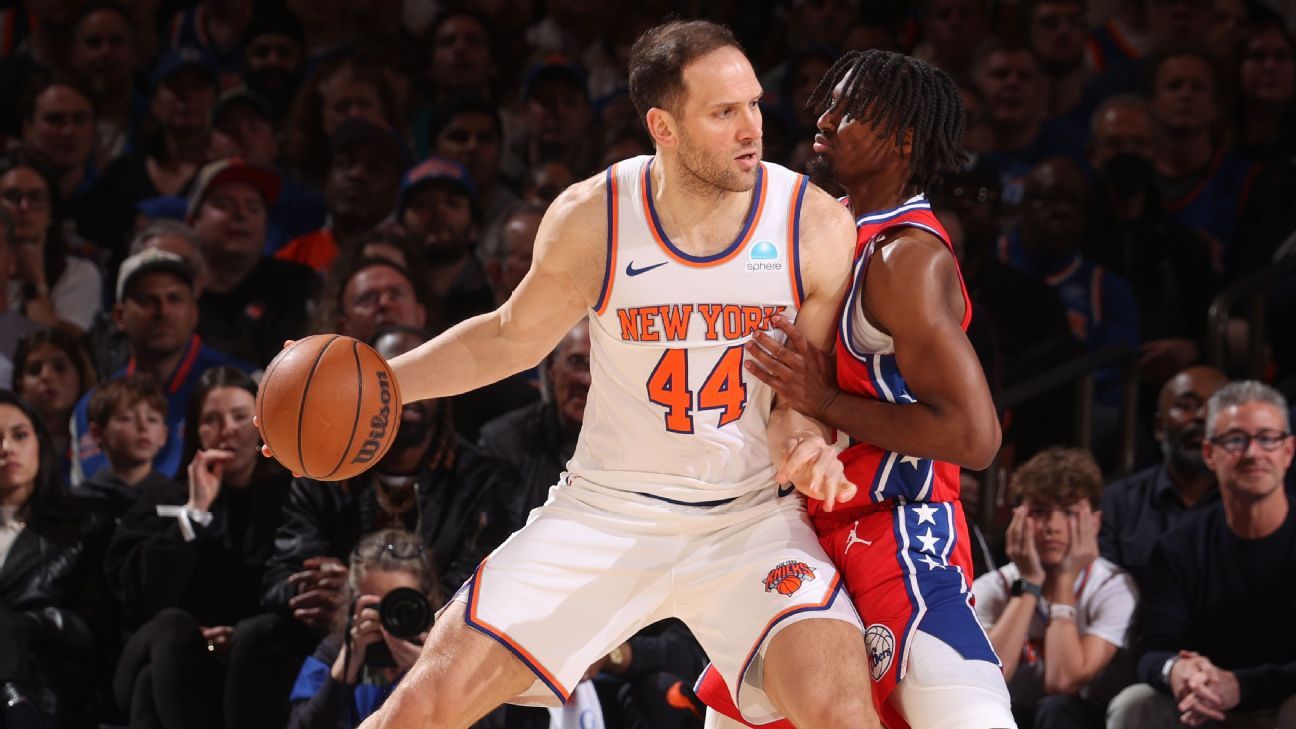NEW YORK — Sitting at his locker before a recent game, New York Mets reliever Jake Diekman marveled at one of his bullpen mate’s pitches. “It’s like this,” Diekman said, preparing to demonstrate a path of movement with his hands. Diekman put his hands close together to show where the pitch starts from. Then he slowly moved his left hand away from his right hand on an invisible plane, stopping after more than a few inches. Just imagine that, he said, going at 92 mph.
“That’s crazy,” Diekman said. “It’s just crazy.”
Diekman wasn’t detailing one of Edwin Díaz’s sliders.
Diekman wasn’t demonstrating a sweeper from Adam Ottavino.
One of Brooks Raley’s sweepers? Nope, not that, either.
The pitch that drew wonder from Diekman — and others in the Mets’ clubhouse recently, for that matter — was a cutter that belonged to Reed Garrett.
Really, Diekman could’ve gushed about any of Garrett’s five pitches.
“They’re nasty,” Mets manager Carlos Mendoza said Tuesday night after Garrett played a key role in the Mets’ 3-1 win over the Pittsburgh Pirates.
Through the Mets’ first 17 games, Garrett has looked like a revelation. Tuesday, Garrett struck out six batters in two scoreless innings. Of the 31 batters Garrett has faced this season, he has struck out 17 (54.8 percent). In 8 2/3 innings, he has yet to allow a run.
Reed Garrett’s 6Ks in 2 innings. pic.twitter.com/JM6CfDifuk
— Rob Friedman (@PitchingNinja) April 17, 2024
All of that from a 31-year-old who carried a career 7.11 ERA into 2024 and whom the Mets claimed off waivers last year.
But that’s how it works for the good teams, right? They see some qualities they like in a pitcher, have the gall to think they can help him and then, voila, he develops into a steady reliever. Teams such as the Houston Astros and Milwaukee Brewers — the last two stops for Mets president of baseball operations David Stearns — have consistently churned out relievers from unlikely places.
The Mets (9-8) wouldn’t know much about that, given their recent turnover. Without much in the form of homegrown relievers, the Mets have had to spend money restocking their bullpen in consecutive offseasons. With more money invested in player development, more continuity with various pitching coaches in the organization and more alignment within a new front office, the Mets are supposed to soon produce hits when it comes to pitchers.
Could Garrett represent a breakthrough?
It’s only mid-April. It’s too early to say. Given this is the first run of sustained success in the majors for Garrett, it’s probably wise to refrain from crowning him just yet. But he’s at least worth monitoring within the context that the Mets need more pitching development wins — and depth within a group that has emerged as an early strength.
After an 0-5 start, the Mets have powered their way over .500 in large part due to their bullpen. Since the Mets dropped to 0-5, the back-end trio of Raley, Ottavino and Díaz have thrown 12 1/3 innings. During that time, they’ve allowed just one earned run, one hit and five walks. They’ve racked up 19 strikeouts.
In returning as the closer after missing all of last season, Díaz has solidified the group, put things in order. The other relievers say they see the ninth inning as accounted for.
“Having ‘Sugar’ back is the best,” Diekman said. “You know you don’t have a whole full inning. The ninth inning? You don’t even have to worry about it.”
But as good as the back end has been, the Mets need more, and that’s especially true when their starting pitchers continue to give them fewer than six innings in close games.
The Mets need a breakout reliever or two.
“There’s always those one or two guys,” Diekman said of successful bullpens.
Reed Garrett has struck out 17 of the 31 batters he’s faced to start the 2024 season 🔥 pic.twitter.com/mvEzhaglBv
— SNY Mets (@SNY_Mets) April 17, 2024
Beyond Garrett, Drew Smith appears to be another candidate. With Raley, Ottavino and Díaz all having just pitched on back-to-back days, 30-year-old Smith on Tuesday recorded the save. Mets officials have been encouraged by Smith’s new cutter, which is giving him a different look from his slider and fastball. Judging by his 117 ERA+ and the steady increase in experience over the past couple of years, it wouldn’t be all that surprising for Smith to progress into a capable back-end reliever — at least not compared to Garrett.
Mendoza, the first-year manager, said Tuesday that he didn’t know much about Garrett’s game. He was taken aback when Garrett flashed 97 mph in spring training. But other Mets officials always liked Garrett, dating to last year. Over the winter, when Stearns made cuts to the roster, he kept Garrett, who held a minor-league option. Because of the option, it was always unlikely Garrett would make the Opening Day roster. But that doesn’t necessarily mean he wasn’t one of their top seven or eight relievers.
For Garrett, the rise in his development dates to last year.
“It got to the point,” Garrett said, “where I needed to decide who I was and what I can do as a pitcher.”
At the end of last season, Garrett worked hard on his sinker. He believed the pitch would be important. Similar to his four-seam fastball, he can throw it in the mid-90s. The movement profile differs, though, which helps him against right-handed and left-handed batters.
From pitching coach Jeremy Hefner’s perspective, being platoon-neutral with an attractive repertoire of pitches might be the biggest key for Garrett. That’s what clubs like the Mets are trying to find, given the three-batter-minimum rule and how so many teams construct their rosters to use platoon substitutions late in games.
Garrett went to the pitching lab after last season but said he threw an unremarkable bullpen. It didn’t matter much to him, he said. That’s because he already believed in the Mets’ coaching staff, including Hefner and Mets vice president of pitching Eric Jagers. They got him to add a cutter to his sinker and sweeper. Then, over the offseason, they had Garrett work on throwing his splitter in the strike zone.
“It’s a collective effort,” Garrett said.
With information, Garrett tried out some new things. Then the staff convinced him to roll out the new pitches and new purposes in games. Good results followed. From there, his confidence grew. It’s a pitching story familiar across all of baseball, yet one that has eluded the Mets in recent years. With someone like Garrett — starter José Buttó is another emerging example — they hope it sticks. The process to this point is at least encouraging.
“You have a guy who has completely bought into himself,” Hefner said, “and understands what he needs to do to have success.”
You can buy tickets to every MLB game here.
(Photo: Brad Penner / USA Today)

Gregory Daniels is your guide to the latest trends, viral sensations, and internet phenomena. With a finger on the pulse of digital culture, he explores what’s trending across social media and pop culture. Gregory enjoys staying ahead of the curve and sharing emerging trends with his readers.








